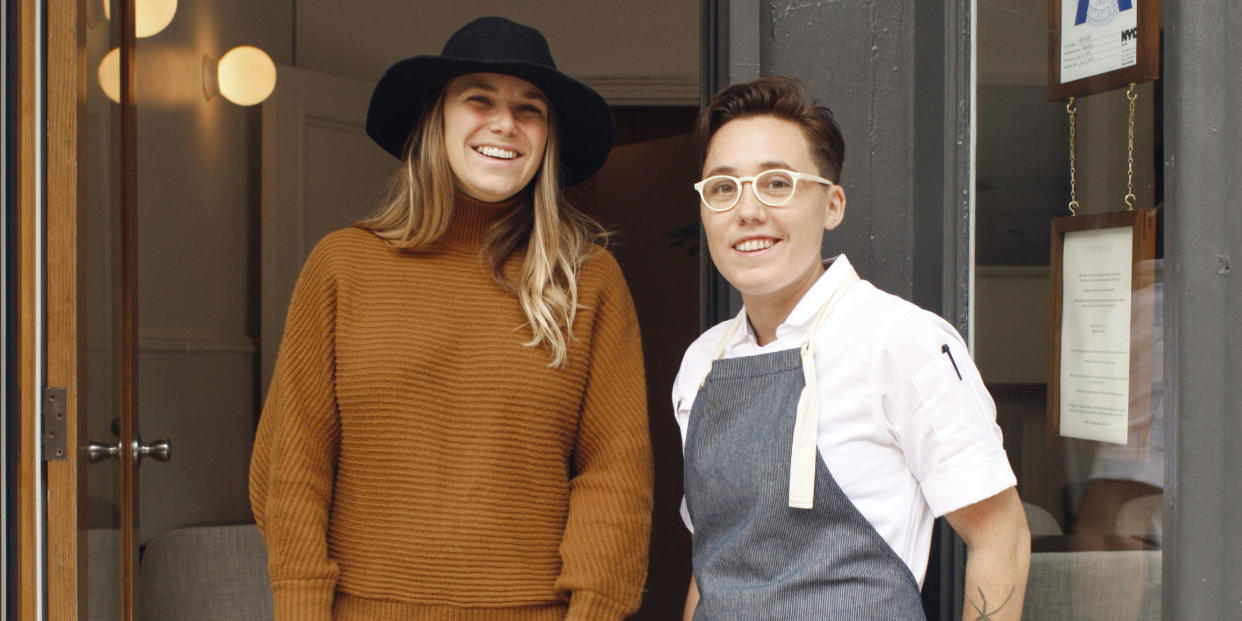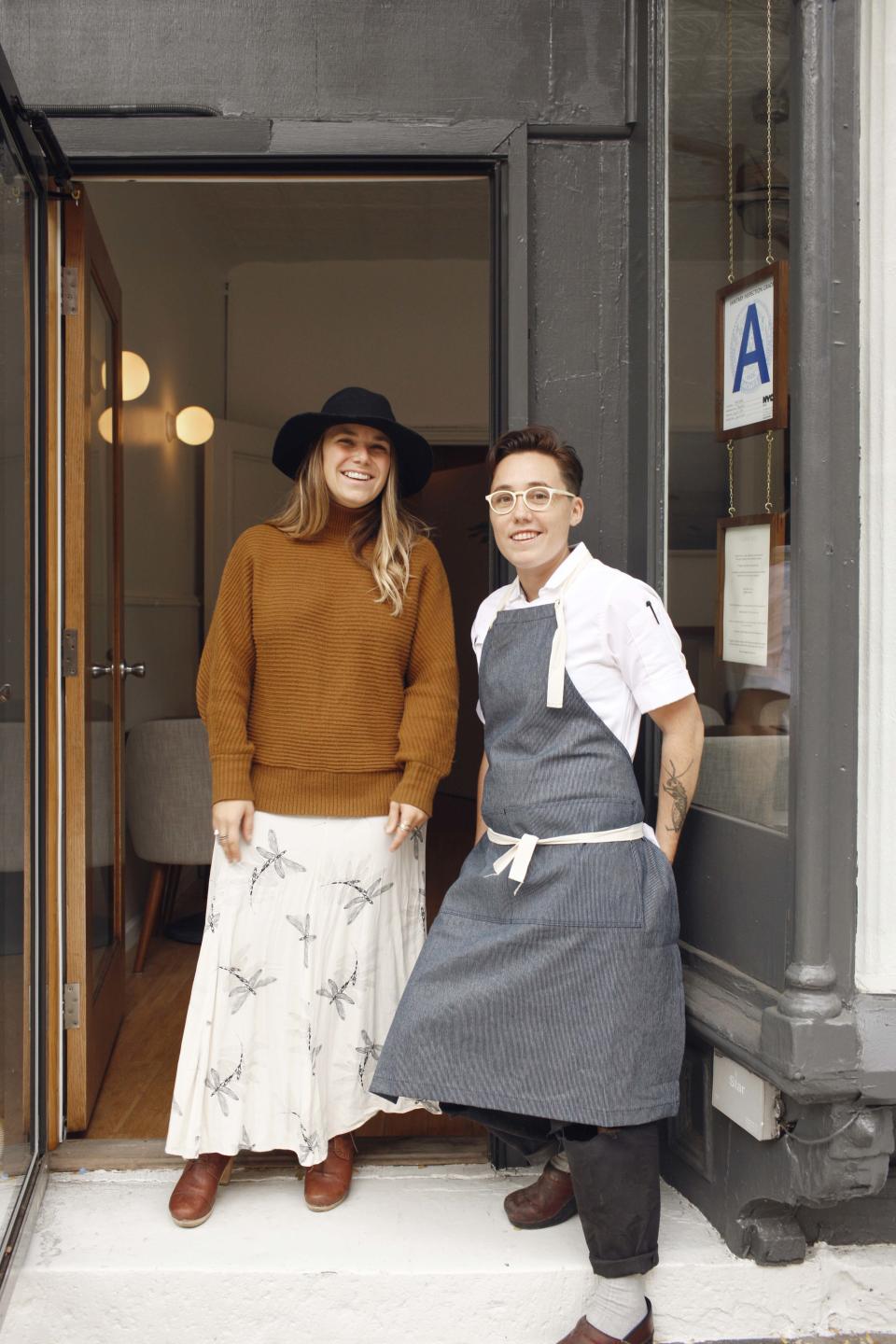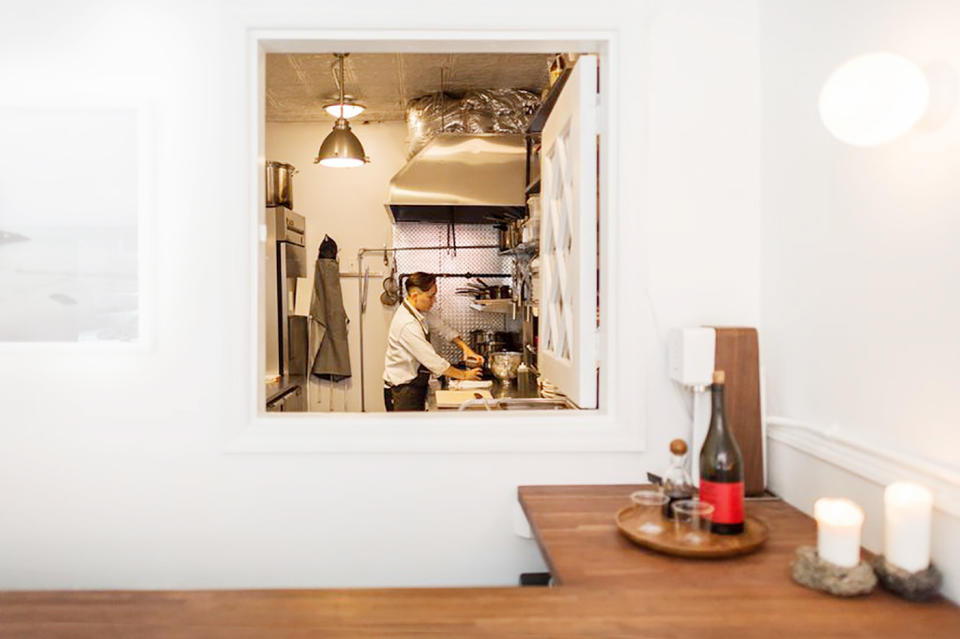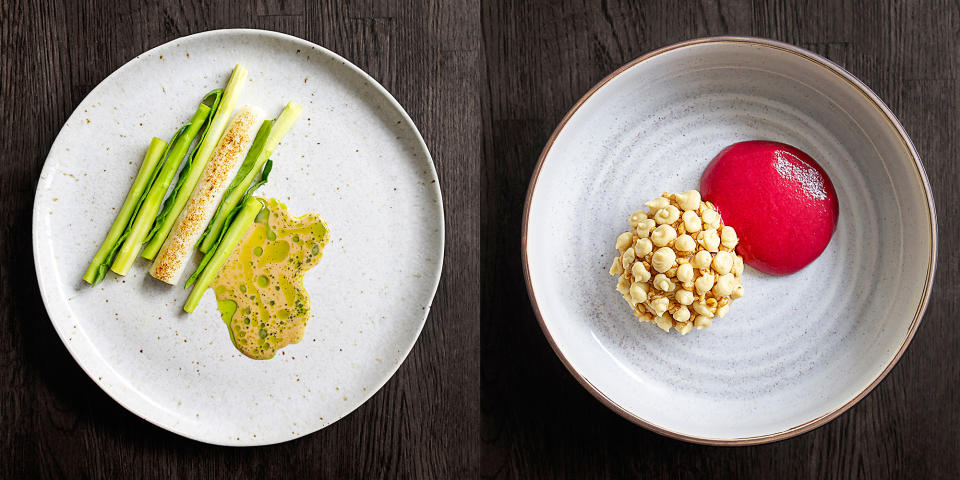The Tiniest Best Restaurant In the World


It's a little before midnight on a Saturday, and Elise Kornack is loading a dishwasher full of plates from the 11-course dinner she's just served at her Brooklyn restaurant, Take Root. Anna Hieronimus, Kornack's wife and the restaurant's only other employee, is in the dining area acting as a de facto coat check for the last of the evening's customers. Even though they're technically in separate rooms, the two are no more than three feet from each other: With just 12 seats (two two-tops, one four-top, and four seats at a counter), their 750-square-foot space, tucked away on a brownstone-lined side street on the border between Cobble Hill and Carroll Gardens, is impossibly tiny, even by Precious Brooklyn standards. As Hieronimus asks one of the last guests what her coat looks like, it's hard not to take in the tableau and think of just how backbreaking it is to run a restaurant, get a business off the ground, and make a name for yourself in this world.
Except that Kornack and Hieronimus already got their big break. Several years ago. In 2015, after less than two years of being open, Take Root-which offers seasonal, nouveau American fare in a format reminiscent of Japanese omakase (i.e., you eat whatever they decide to feed you)-reached a level of recognition that 99 percent of restaurants never come close to. They racked up a James Beard award; received kudos from the New York Times, New York magazine, and ELLE; and, most impressive, earned a Michelin star. The ensuing customer interest prompted one critic to declare that in the foodie world, "there are two types of people in New York right now: those who have eaten at Take Root and those who are trying to eat there."
Yet the expected next beat-in which they spin off into several locations, serve as judges on Top Chef, publish a cookbook, and host a podcast-never sounded. Almost four years in, it's becoming clear that Kornack and Hieronimus don't want it to. They remain the restaurant's sole employees, and Take Root is open only Thursday through Saturday, for just one seating per night. (Yes, 36 customers a week.) They haven't even sprung for someone to help with the dishwashing. Which is where Take Root deviates from being the beginning of a success story and becomes a story unto itself about redefining success.
In a culture where bigger is considered better, where "Is it scalable?" is almost a meme, Take Root just might be one of the most radical restaurants on the American dining scene right now, and Hieronimus and Kornack two of its most progressive players.
"What they're doing is incredibly unique in an industry with everyone wanting to be a star or a celebrity chef," says Jori Jayne Emde, co-owner of the acclaimed Hudson Valley restaurant Fish & Game and a friend of the couple's. The conventional wisdom, she says, "is that in order to have brand recognition, you have to roll out multiple concepts. But I don't think that defines success. I think you can have one incredibly special restaurant."
When I meet Hieronimus and Kornack at Take Root one winter morning during off hours, I'm struck by how incredibly marketable they are: attractive and just 29 and 30 years old, respectively; Kornack, with her partially shaved head and trademark glasses, is exactly what central casting would want in a cool Brooklyn chef. But within seconds, it's clear they're wired differently than their peers. While most restaurateurs would be running back and forth from the kitchen during an interview, serving up a taste of this and that, Kornack and Hieronimus offer…a glass of water. And sit, a tad formally, opposite me at their four-top.
They have the kind of sentence-finishing symbiosis you'd expect from people who spend 16 hours a day together (and sleep next to each other each night). They're also perfect foils for each other. Hieronimus, the more bubbly of the two, is suited to handling the front of house (and everything else outside of food, including the wine program); Kornack, the cerebral introvert, is more at home toiling in the kitchen by herself and prone to comments such as "If somebody's not going to eat something [I've cooked], they're an idiot." Followed by: "Anna's going to be, like, 'That wasn't nice to say.' "
The couple were introduced by a mutual friend at a bar seven years ago. (They married in 2013.) At the time, they'd both just graduated from college (Kornack from Bates College in Maine, Hieronimus from Hofstra University in New York). Kornack had taken a left turn from the fine arts she'd majored in and stints working in art galleries, and was working for April Bloomfield as a lead cook at Bloomfield's West Village gastropub, The Spotted Pig. (She'd later do a short gig as sous chef at Marcus Samuelsson's Aquavit.) Hieronimus, meanwhile, had dabbled in nonprofits and retail and had gotten her yoga-instructor certification.
Take Root is one of fewer than 15 woman–helmed American restaurants to earn a Michelin star.
It took a few years before they decided to open their own restaurant; the idea was born, in part, out of working and living on someone else's schedule. "When we were dating, Elise was getting home at 3 a.m., and I'd have to go out to meet her to see her after work," Hieronimus says. It occurred to them that there was an opening in the market for an establishment that had the theatrics, and control, of a tasting menu without the bucket-list prices or formality of, say, a Per Se. "Those experiences are really special and really fun, but there's this moment of 'Do I feel out of place here?' You look around at the really rich European diners who are dropping, like, $500 to $1,000 on a bottle," Kornack says. "We wanted to create something where people who really wanted to eat good, progressive, creative food could-but they could wear jeans." She set out to design a menu, currently at a relatively reasonable $125 per plate, that, as she puts it, "rides the line between comfort and intrigue." She'll follow a course of fresh-from-the-oven brioche "that's like a hug" with the German root vegetable kohlrabi, which "75 percent of customers have never even heard of."

They were right; there was a market. They get offers-almost every day-for potential investors, cookbook deals, second locations, and "every single food show there is," Hier-onimus says. "They always ask to speak to me. They're like, 'Can we convince your wife? Maybe if you tell her it's a good idea, she'll do it.' " Needless to say, they're not interested. "What we've created is this very special, intimate dining experience," she adds. "I think to expand it in any way would change the entire essence of what we've built."
"There's literally no restaurant, not in this city, not in this country, not in the world, where the owner is doing [all the things we do] at the level we're at reputation-wise, I can almost guarantee you," Kornack says. "So in the morning I'm covered in trash water [because] my trash bag is breaking, and then I'm, like, cleaning the floor. Then I'm also tasting and creating a Michelin-star tasting menu. Anna is watering the plants, sweeping the floor, scraping up some butter that fell down, and then also creating this amazing wine list. For us, Take Root is this space where we can shut everything else out."
They're particularly proud that they have no investors. "A number of chefs I'm friendly with have said investors have been a detriment creatively," Kornack says. "They'll say, 'Oh, you won this award; we need to expand now,' and [the chef] will get stuck doing it because they've signed a contract, and then they're like, 'Creatively, I wasn't ready to do that.' Sometimes that can compromise both the flagship and the expansion."
Take Root is singular not only for its scale. It's also one of fewer than 15 woman–helmed American restaurants to earn a Michelin star, and part of a handful of woman-run elite restaurants to offer a tasting menu (others include Atelier Crenn in San Francisco and Elizabeth in Chicago). "Women are traditionally seen as nurturers; we feel pressure to be accommodating," says Kerry Diamond, cofounder of cult food magazine Cherry Bombe. "It takes a lot of confidence to say, 'No, you're going to eat what I make.' "
Their venture isn't just redefining the idea of what it means to be successful; it's also pushing the boundaries of what a restaurant can be in the process. When I dine there on a recent Saturday night, I'm struck by how much it blurs the line between dinner party and restaurant. Hieronimus is playing songs from her iPhone (an eclectic mix that includes Patsy Cline and an unplugged Ed Sheeran cover of Blackstreet's "No Diggity"), while Kornack is in the kitchen putting the finishing touches on dishes. (She personally delivers each plate to diners, a process that involves ticking through the ingredients of 11 courses to six separate parties.) It's clear Kornack takes pains to think through each course: There's a beetroot and shrimp pastry that she serves in a mini cake dome ("it's a surprise because you don't expect it to be savory"), a roasted onion soup that comes with a side of aromatic oil dispensed in an eyedropper.
"The words always and never are such polarizing words," Kornack says. "The customer is often right."
When my dining companion compliments Kornack's decision to serve an apple-and-eucalyptus ice cream with a wooden, rather than cold metal, spoon-the better to enjoy its temperature and flavor-the chef beams. It's my friend's genuinely felt sentiment, but it also seems like the polite thing to say. Just as it's expected that dinner party guests will be gracious to a host, there's an assumption, at least on Kornack's part, that customers should be grateful.
"You're told in every industry that the customer is always right," Kornack says. "And that's the exact opposite thing you should ever go by, because-"
"You should treat customers with respect, no matter what," Hieronimus interrupts her wife.
"Well, always and never are such polarizing words," Kornack replies. "The customer is often right."
(And you're told when you're not: When I arrive at 8:03, I'm reminded by Hieronimus that dinner begins promptly at eight. House rules.)
There may be some magic in taking power away from the customer, because Take Root diners consistently employ a special kind of over-the-top praise. "It's like being looked after when you're sick," said a 2016 New Yorker review with the headline "The Tasting Menu That Cares for You." "It's a rare thing to pay for a meal but feel as if it were a gift," enthused the New York Times in 2013. "It sounds cheesy, but you really feel the love in that restaurant," says Sierra Tishgart, an editor at New York magazine's Grub Street food blog, who ranks Take Root as her favorite fine-dining experience.
"I've been to a lot of restaurants-places like Le Bernardin-and they're excellent. But they don't feel personal," says Jennifer Chan, a customer who has become such a superfan that she's altered travel plans in an effort to score a coveted reservation; she's eaten there eight times. "Take Root feels like coming home to something. There's just a lot of love; I don't know another way to say it."
Undoubtedly, Take Root's decision to stay small has proved a smart marketing strategy. Lucky Peach, the food magazine owned by Momofuku's David Chang (a person who knows about scalability), perhaps summed it up best in a write-up of Take Root titled "Two Employees, One Michelin Star." It's a novelty even outside the restaurant industry. Author and branding expert Seth Godin explains: "Since 2000, technology and other innovations have made it easier for businesses to increase yield: 'We've gotta make it cheaper and bigger.' So few companies are asking the right question: 'How do I make it better?' "
There's also something to be said for the unending desire for that which you can't have. It's hard to quantify exactly how difficult it is to get a reservation at Take Root. Its reservation system, accessed through its website, allows customers to book no more than 30 days in advance, starting at midnight-a process that's akin to getting a hot item on Gilt. But, to give an idea of just how fierce the competition is: On election night, while most Americans were glued to cable news, a quorum of foodies was on Take Root's site. By the time Clinton called Trump to concede, dinner for a month from that date was completely booked.
Still, there are limitations to their scale that even the couple cop to. They don't have a plan B if there's an emergency and one of them takes ill. (This has happened only once; they had to reschedule dinner service.) And the smallness can encourage a level of familiarity in their customers that the couple find off-putting. "People will ask us crazy things," Hieronimus says,"from flattering questions like 'I can't wait to talk with you after the meal about how you did this' to 'Are you guys even making money?' Like, geez. Really inappropriate."

Money is actually the one topic they find to be most rude. That said, there are some financial advantages to staying small. No support staff to pay and no food wasted. One of the bêtes noires of chefs everywhere is gauging what ingredients to buy and in what quantities-not knowing how many customers they'll serve on a given night or who will order what from the menu. Chefs who can't master this balance inevitably find themselves without a kitchen to run.
"This is a studio, the way I see it. Some people have apprentices who clean their paintbrushes; some don't."
In the restaurant business, "the hours are long, you don't have holidays off, and there's not a lot of money in it," says Emde, who owns Fish & Game with her husband, Zakary Pelaccio. "If you find a mate outside the industry, they have to know what the industry requires. My husband and I are not side by side in the kitchen every day, and at this point I don't think that would work for us. Anna and Elise seem to have it figured out."
Yes…but their world is very circumscribed. They live just around the corner from Take Root, arriving at the restaurant six out of seven days a week at 10 a.m. and leaving around midnight. (On days when they don't have dinner service, they're planning menus and paying bills.) "Sometimes it feels like we're existing all on this one block," Hieronimus admits. They once shut down the restaurant for a few months because they had to make some repairs, and because they were exhausted.
Though the couple insist they've decided to stay small not "out of fear," I wonder if this is entirely true. I ask Kornack if she's ever been called a control freak. Yes, she says, and adds, "I always believe that instead of pushing away things about yourself that may have a negative connotation, you should say okay, and just own them."
There's a big gulf between selling out to reality TV and selling out to hire a dishwasher. When I ask Kornack, "Why not just hire a dishwasher?," she replies, "This is a studio, the way I see it. Some people have apprentices who clean their paintbrushes; some don't. When I worked at art galleries on Nantucket, there were some who sold their $22,000 painting and were like, 'Okay, now I need a staff of three or four.' And there were others who still don't have any staff. That's just how I do it." Later, she says more directly, "I just wouldn't want to have someone in my space." Unless you are Anna Hieronimus, or one of the 12 people who get to partake of this performance art–cum–lovefest–cum dinner-out-in-Brooklyn, three nights a week.
This article originally appeared in the March 2017 issue of ELLE.
Editor's Note: After this piece was reported, Elise Kornack and Anna Hieronimus announced that they would be closing Take Root this spring. The couple has not yet announced their next project, but, says Hieronimus: "We do of course have plans for future endeavors that will be another small operation."
You Might Also Like

